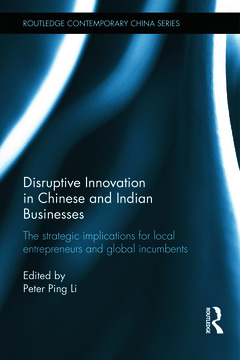Disruptive Innovation in Chinese and Indian Businesses The Strategic Implications for Local Entrepreneurs and Global Incumbents Routledge Contemporary China Series
Coordonnateur : Ping Li Peter

With the rapid development of China and India as new economic powers in global competition, an obvious question is whether these emerging economies are great opportunities or threats. Whilst answers are bound to differ depending on one?s perspective, it is increasingly clear that more local firms, especially local entrepreneurs, from these emerging economies will play a more critical role in global competition by becoming challengers to global incumbents. Indeed, the fact that the majority of their populations are at the bottom of the pyramid, and thus cannot afford products designed for the developed markets, has made these emerging economies fertile ground for developing and applying disruptive innovations.
A novel mix of key attributes distinctive from those of established technologies or business models, disruptive innovations are typically inferior, yet affordable and "good-enough" products or services, which originate in lower-end market segments, but later move up to compete with those provided by incumbent firms. This book sheds new light on disruptive innovations both from and for the bottom of the pyramid in China and India, from the point of view of local entrepreneurs and international firms seeking to operate their businesses there. It covers both the theoretical and practical implications of disruptive innovation using conceptual frameworks alongside detailed case studies, whilst also providing a comparison of conditions and strategic options in India and China. Further, unlike existing studies, this book focuses on the neglected perspective of local challengers as the primary players, and in doing so reveals the extent to which the future landscape of global competition may be shaped by disruptive innovation, as well as its capacity to make the world "flatter" and more sustainable.
This unique book will be valuable to both scholars and practitioners interested in disruptive innovation and those working in the fields of Asian studies, international business, economics and globalization.
1. Introduction: Disruptive Innovation from the Bottom of the Pyramid: The Strategic Implications for Local Challengers and Global Incumbents Part I: The Contexts for DI from China and India 2. Economic Competitiveness and Disruptive Innovation: Exploring the Macro and Micro Contexts in China and India 3. The Role of Government in an Emerging Disruptive Innovation: The Case of E-bike in China 4. The Emerging Pattern of Disruptive Innovation from the Bottom of the Pyramid Part II: The Strategies of DI for Local Challengers 5. Mapping Innovations in the Disruptive Innovation Realm in India: What and Where in the National Pyramid of India 6. Transformative Capacity and Absorptive Capacity: The Rising Chinese Wind Turbine Suppliers 7. Disruptive Innovation in China’s "Shanzhai" Cell Phone Industry: Theory-Building via Case Study Part III: The Strategies of DI for Global Incumbents 8. Disruptive Innovation at the Bottom of the Pyramid: What Role Can Western Established Firms Play? 9. The New Wave of Disruptive Innovation from China: Why and How Global Incumbents Need to Respond 10. Ambidextrous Capability: The Case of Japanese Enterprises 11. Conclusion: Future Research Agenda
Peter Ping Li is Professor of Chinese Business Studies at Copenhagen Business School, Denmark
Date de parution : 02-2013
15.6x23.4 cm
Disponible chez l'éditeur (délai d'approvisionnement : 14 jours).
Prix indicatif 172,36 €
Ajouter au panierDate de parution : 09-2015
15.6x23.4 cm
Disponible chez l'éditeur (délai d'approvisionnement : 14 jours).
Prix indicatif 53,83 €
Ajouter au panierThèmes de Disruptive Innovation in Chinese and Indian Businesses :
Mots-clés :
global; incumbents; low; end; market; local; entrepreneurs; frugal; model; dynamic; USA’s Project; Global Incumbents; Ambidextrous Capability; Direct Drive Permanent Magnet; Technological Innovations System Literature; Bop Market; Frugal Innovation; Chinese Government; Low End Market; Business Model Innovation; High End Market; Imitative Innovation; Clean Slate Approach; Unique Local Context; Disruptive Technological Innovation; Electric Vehicles; Tata Nano; Clean Slate; Cell Phone Manufacturers; Cell Phone Industry; Wind Turbine; Reverse Innovation; Fringe Market; BoP Community; MW Wind Turbine



